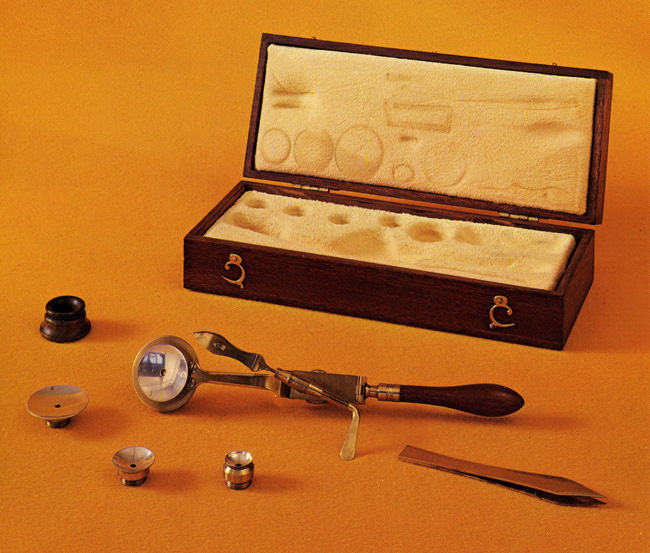For some years the Society’s History Committee has been trying to set up a collection of antique microscopes for exhibition and display purposes. Although we do possess a ʻCollectionʼ of rare microscopes and accessories, it is no longer feasible to put any of these on display at major events and conferences, such as the on-going mmc series; and it comes as no surprise to find that the majority of such instruments are now locked away in museums, or in private collections. Also, the small number which occasionally do appear in salerooms command very high prices. The new collection is thus being set up in response to the need for a collection of significant, but also accessible, instruments.
One of our committee came across a booklet describing an interesting series of reproduction microscopes – “Replica Rara” – which had been created in the early 1970s. Closer investigation revealed that this collection of instruments had been commissioned by Dr James McCormick, a pathologist and also a keen collector of antique microscopes, based in Chicago. His vision was to produce a set of microscopes, exact replicas of historically important instruments covering their development from 17th through to the 19th centuries. These could then be made available to colleges and schools as a means of promoting the research and study of microscope development.
The link with the RMS came about in a surprisingly fortuitous manner. Dr McCormick was visiting the Science History Museum in Oxford around 1969, inspecting its impressive display of antique microscopes, when the attendant offered to introduce him to Dr Gerard Turner, the specialist curator of microscopes, who happened to be in the museum at the time, and who would later serve the Society as Secretary and President. A friendship started then, which lasted until Gerard’s sad passing in 2012. With a common interest and enthusiasm for antique instruments, their friendship developed and when Dr McCormick shared his vision with Gerard, they then set out to identify a small number and have left us with a unique heritage which is of relevance and interest to all microscopists today.
Following close examination of the instruments illustrated in the Replica Rara catalogue, the History Committee decided to try to acquire one instrument from Dr & Mrs McCormick– a beautiful replica of an “Old English” Tripod microscope from the mid- 17th century, shown in Fig. 1.

Figure 1. Old English Tripod microscope, ~ 1680
Following detailed discussions with Dr & Mrs McCormick, they decided to make a most generous gift to the RMS which would include not only this instrument, but an additional seven others, ranging from a small Van Leeuwenhoek microscope to an unusual instrument made in Edinburgh around 1750 by a William Robertson, which could also be used as a Solar Microscope. (Fig. 2)

Figure 2. Robertson Screw-Barrel Microscope. ~ 1750
This rare example is actually an exact copy of the original instrument, in the RMS’s own Collection.
More unusual instruments in the Collection include a Lieberkuhn-type Simple Compass Microscope from around 1800 (Fig. 3). These would be used by botanists in field-work, as they were extremely portable.

Figure 3. Lieberkuhn – type microscope, 1800
The simplest instrument in the collection is a Continental Wooden microscope, (Fig. 4) again early 19th Century. These were made and sold in Germany by ‘toy-makers’, to introduce young people to the wonders of the microscopic world.

Figure 4. Coninental Fruitwood Microscope
Along with the eight microscopes, the gift includes a Reference Library which contains a fine, leather-bound facsimile copy of Robert Hooke’s ‘Micrographia’ and other significant volumes covering the development of microscopy.
The Dr. James B. & Suzanne C. McCormick Science Heritage Instrument Collection and Reference Library are now in the RMS office, with the microscopes set up in their own display cabinet. (Fig. 5)

Figure 5. The McCormick Collection of Microscopes
This collection recognises the McCormicks’ close friendship with Dr Turner and his close involvement in the project, and also the encouragement of the late Dr Brian Bracegirdle, also a former Secretary of the RMS. Brian was author or co-author of two of the volumes in the Library. It is a fitting tribute that the instruments, which were conceived in Oxford, have now returned to Oxford where they will form a valuable resource for the promotion of the historical development of optical microscopy, which is, after all, where the RMS had its own roots.
